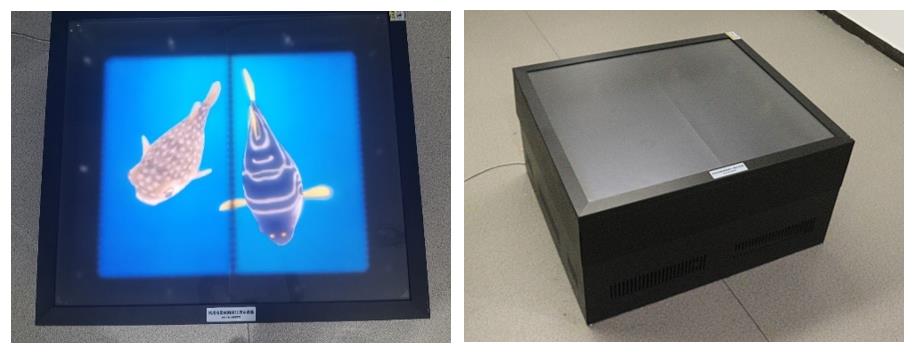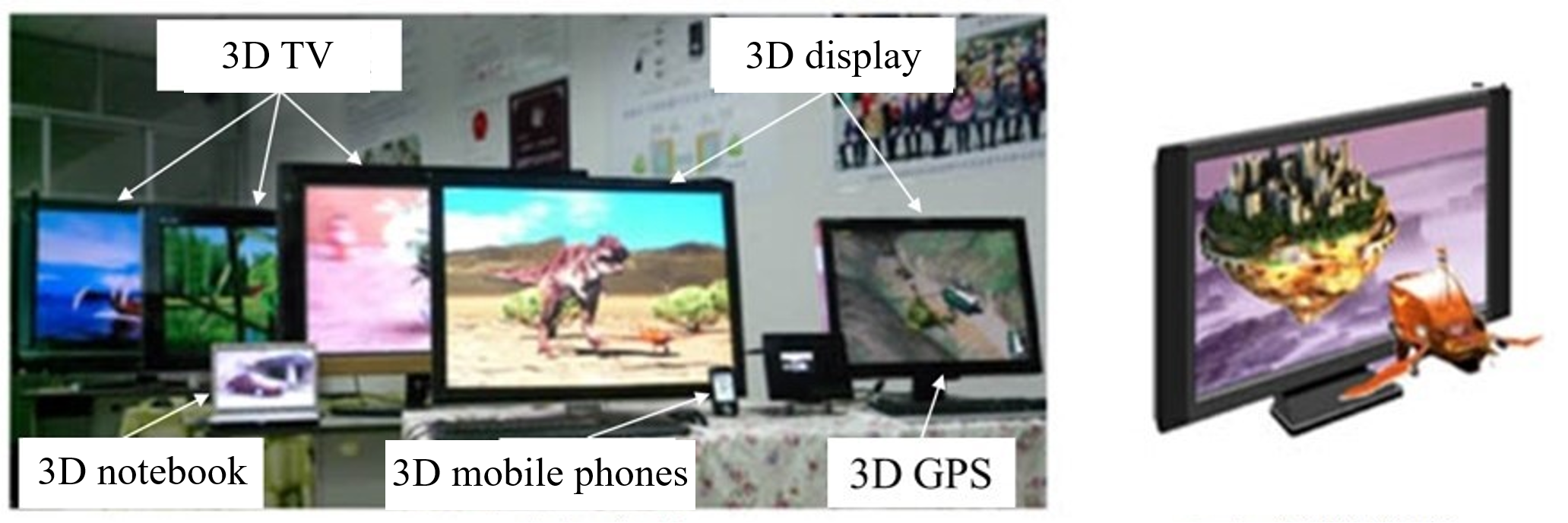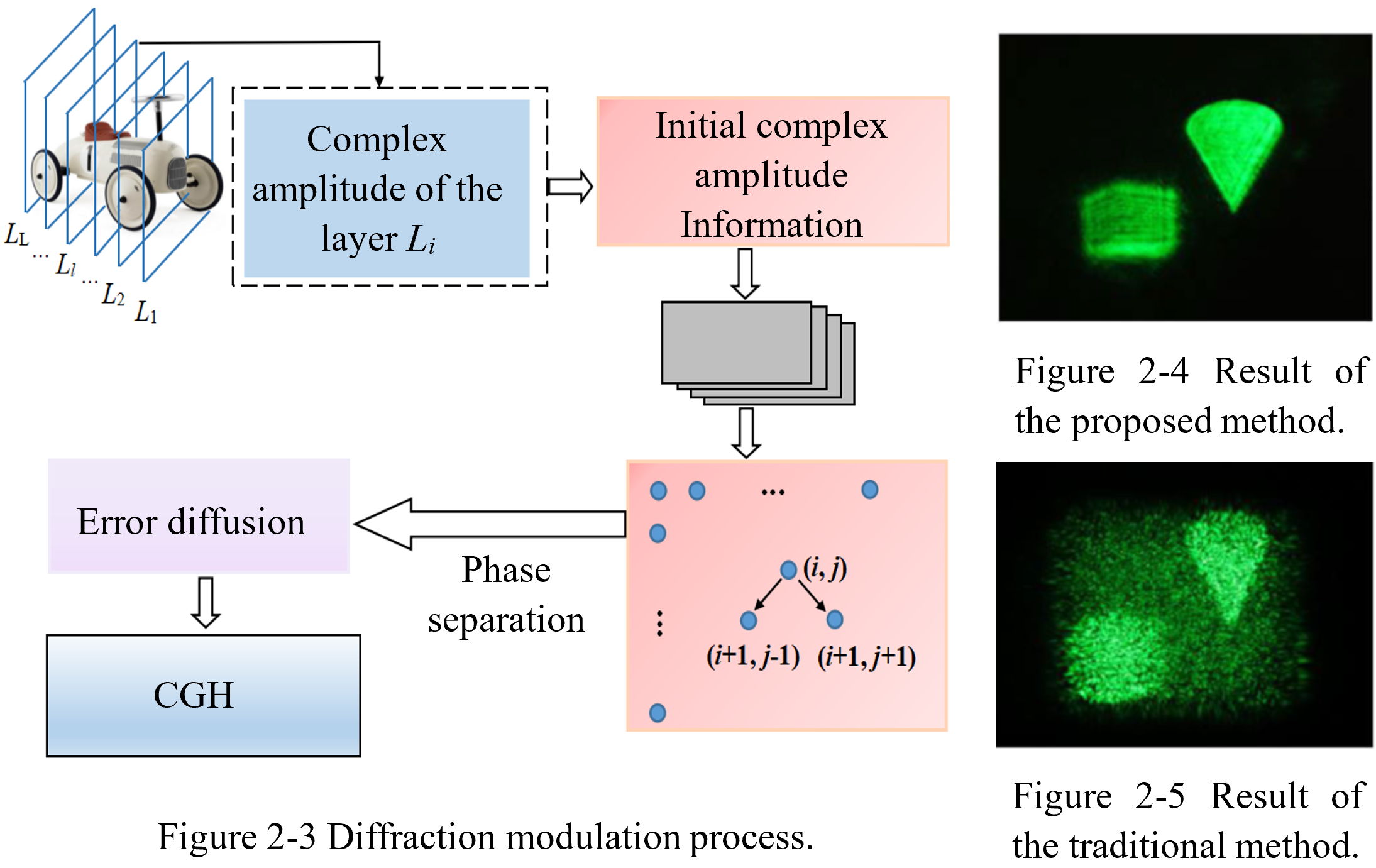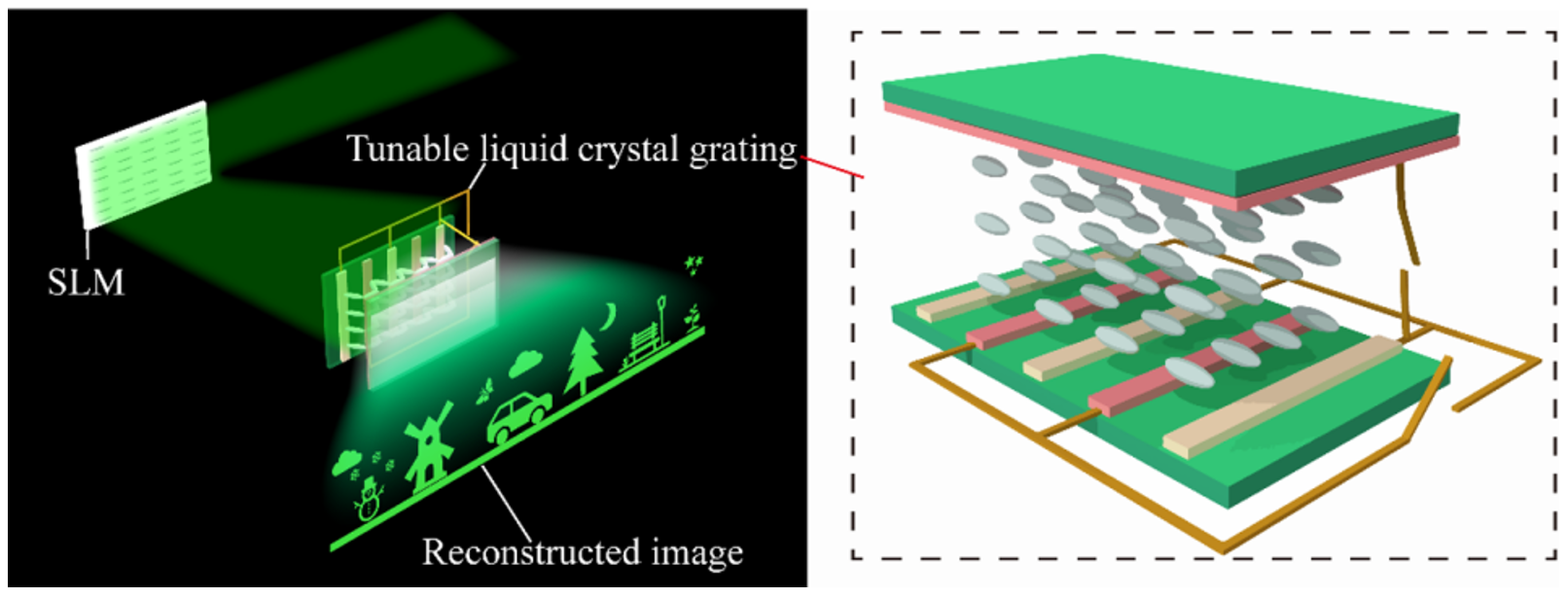1. Glasses-free integral imaging and autostereoscopic 3D display technology
Integral imaging and autostereoscopic 3D displays are two essential types of glasses-free 3D display technologies. The glasses-free integral imaging light field 3D displays, glasses-free autostereoscopic 3D displays, 3D cameras, real-time 3D capture and display systems, interactive glasses-free 3D display systems, and glasses-free 3D image video processing software have been developed.
1.1 Tabletop glasses-free integral imaging light field 3D display
The 43.5-inch tabletop glasses-free integral imaging light field 3D display has been developed to achieve a 360° horizontal viewing angle and 68.5° vertical viewing angle, which can be applied to various scenarios such as electronic sandbox and multi-person collaborative work.

(a) Display 3D image (b) Without 3D image
Figure 1-1 Tabletop glasses-free integral imaging light field 3D display system
1.2 High resolution glasses-free integral imaging light field 3D display
The 15.6-inch high resolution glasses-free integral imaging light field 3D display has been developed to provide clear images, comfortable viewing experience, and strong sense of stereo.

Figure 1-2 High resolution glasses-free integral imaging light field 3D display
1.3 Glasses-free autostereoscopic 3D display
A variety of high-performance glasses-free autostereoscopic 3D displays and glasses-free autostereoscopic 3D projection systems have been developed. Without glasses, the viewer can see a 3D scene floating out of the screen and reaching deep into the screen, with an immersive and vivid effect.

(a)Real objects (b) Effect model
Figure 1-3 Glasses-free autostereoscopic 3D display

|
Figure 1-4 High resolution naked-eye autostereoscopic 3D rear and front projection systems |
1.4 Multi-view 3D camera
The developed multi-view 3D cameras provide live sources for glasses-free autostereoscopic 3D displays and also provide a live source for glasses-free integral imaging 3D displays according to our own patented technology.

|
Figure 1-5 Eight-view 3D camera and four-view 3D camera |
1.5 Real-time integral imaging 3D capture and display system
The real-time integral imaging 3D capture and display system based on a network camera array has been developed, consisting of an 8×8 network camera array, a gigabit network PoE switch, a workstation and a glasses-free integral imaging 3D display. The system achieves real-time capture and display of real scene 3D information at a frame rate of up to 37 frames per second.

|
Figure 1-6 Real-time integral imaging 3D capture and display system |
|
1.6 Real-time glasses-free autostereoscopic 3D capture and display system
The developed real-time glasses-free 3D capture and display system consists of a computer, a glasses-free autostereoscopic 3D display and a 3D camera. The system has a start-up time lag of less than 100ms and runs at a frame rate at 18-30fps. It can be used in the field of 3D filming preview, 3D monitoring and 3D video conferencing.

|
Figure 1-7 Real-time glasses-free autostereoscopic 3D capture and display system I |

|
Figure 1-8 Real-time glasses-free autostereoscopic 3D capture and display system II |
1.7 Interactive glasses-free autostereoscopic 3D display system
The interactive glasses-free autostereoscopic 3D display system based on Kinect uses a fusion of non-contact human pose perception and autostereoscopic 3D display technology to control 3D scenes through gestures for convenient human-computer interaction. The system has potential applications in the areas such as gaming and interactive TV.

|
Figure 1-9 Interactive glasses-free autostereoscopic 3D display system |
1.8 Glasses-free 3D image video processing software
Video player for glasses-free 3D display, device assembly and testing software, 3D image recording software, and 2D/3D video real-time conversion software have been developed. The self-developed GPU processing algorithms are used for high operational efficiency.
2. Holographic 3D display technology
Holographic 3D display is one of the most ideal 3D display methods. Focusing on the improvement of holographic 3D display performance, a fast generation method of the hologram, high-resolution holographic display technology and large-size holographic 3D display technology with large viewing angle have been proposed. The holographic 3D display effect with fast high-resolution, large viewing angle and large size has been realized. The research result is expected to be applied in the areas such as VR/AR.
2.1 Fast generation method of the hologram
To solve the problem of slow calculation speed of the hologram in holographic 3D display, a fast generation method of 3D object hologram based on the optimal segmentation of sub-holograms has been proposed. The method improves the speed by more than 40% (Optics Express, 28(21), 32185-32198, 2020).

Figure 2-1 Flow chart of the fast generation method of hologram.

Figure 2-2 Calculation speed comparison.
2.2 High-resolution holographic display technology
To solve the problem of low resolution caused by serious speckle noise in holographic display, a synergistic processing technology of light source optimization and diffraction modulation has been proposed. The signal-to-noise ratio is improved by more than 10 times and the high-resolution holographic 3D display is realized (Optics Express, 30(2), 3157-3171, 2022).

2.3 Tunable liquid crystal grating based holographic 3D display system with wide viewing angle and large size
A tunable liquid crystal grating based holographic 3D display system with wide viewing angle and large size has been proposed. The system uses the tunable liquid crystal grating for secondary diffraction of the holographic reproduction image, and uses the two proposed hologram generation methods to realize the wide-viewing angle and large-size holographic 3D display, respectively. The system has a viewing angle of 57.4° and the size of the reconstructed image is enlarged by about 4.2 times.

Figure 2-6 Diagram of the tunable liquid crystal grating based
holographic 3D display system with wide viewing angle and large size.

Figure 2-7 Principle of the holographic 3D display with wide viewing angle.
(a) Viewing angle in the initial state. (b) Viewing angle when the voltage is applied to the tunable liquid crystal grating.

Figure 2-8 Principle of the holographic 3D display with large size.
3. Liquid photonic device and imaging technology
3.1 Electrowetting liquid lens
The electrowetting liquid lenses with various structures have been developed. They have the characteristics of withstanding high voltage of 160V and low driving voltage of 12V. The driving hardware and software for the liquid lenses have been developed.

Figure 3-1 Electrowetting liquid lens samples and driving software/hardware
3.2 Continuous optical zoom microscope
The 10×-60× continuous optical zoom microscope based on liquid lens has been developed, with resolution of 1.5μm, switching time of 50ms, and axial depth scanning of 1mm.


Figure 3-2 Continuous zoom microscope prototype and imaging results
3.3 Imaging device based on liquid lens
Several continuous optical zoom imaging devices based on liquid lens are developed to realize the adaptive lightweight zoom imaging function.

Figure 3-3 Continuous optical zoom imaging device based on liquid lens
4. Liquid crystal technology
Liquid crystal (LC) is an intermediate state between the liquids and crystals, and therefore it has both the fluidity of liquids and the anisotropy of crystals. We have engaged in the research of LC technologies and their applications in lens, displays, light field modulation, two-dimensional and blue phase LC materials.
4.1 LC lens array
A thin LC lens array with low operating voltage (5.4V) and fast response speed (28ms) has been developed. It has a promising application prospect in 2D/3D switching display and other fileds.

Figure 4-1 Structure and principle of the LC lens array

Figure 4-2 Zoom characteristics of the LC lens array
4.2 2D/3D compatible display screen based on LC lens array
A 2D/3D compatible display screen based on LC lens array has been developed. By adjusting the voltage, it can switch between the 2D full screen display, 3D full screen display and the 2D/3D compatible display on one single screen. All display images are clear enough in each mode (Optics Express, 29(23), 37464, 2021).

Figure 4-3 2D display mode

Figure 4-4 3D display mode
4.3 Color LCoS micro display
A color LCoS micro display with low fringe field effect is developed, which realizes the sequential color display with a contrast ratio of 1000:1 and a display frame rate of 180Hz.


Figure 4-5 LCoS micro display Figure 4-6 Color display effect
4.4 LC material with super large Kerr constant
It is proved for the first time that graphene oxide liquid crystal (GO-LC) mesophase exists, and the Kerr constant is as high as 10-5m/V2. The high stability and high Kerr constant offer possibilities for the application of GO-LC in display devices (Nature Materials, 13, 394, 2014).

Figure 4-7 Phase sequence of the GO-LC

Figure 4-8 Alignment effect of the GO-LC